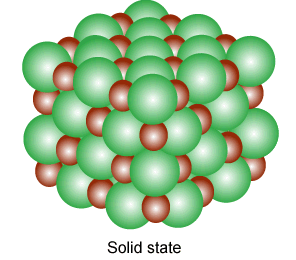F-centres in an ionic crystal are
- lattice sites containing electrons
- interstitial sites containing electrons
- lattice sites that are vacant
- intertitial sites containing cations
The Correct Option is A
Approach Solution - 1
F-centers are lattice sites containing electrons. It is a crystallographic defect. In this electron fills the anionic vacancy generated.
Read more from chapter: Solid State
Approach Solution -2
The Correct Answer is (A)
Real Life Applications
F centers are used to form:
- Lasers, that produce light of a single wavelength.
- Scintillators will generate electrical signals from light sources. They are used in medical imaging.
- Phosphors form light when exposed to certain radiation.
- F center absorbs light from the visible region and therefore acts as a coloring agent.

Question can also be asked as
- What are f centers?
- What are the properties of the f center?
- How are f centers formed?
Approach Solution -3
The Correct Answer is (A)
Crystals are not perfect, even though they have short-range and long-range orders of arrangement. Here are four types of defects observed in crystals. They are as follows:
- Point defect
- Line defect
- Volume defect
- Surface defect
Point defect
Point defects occur around a particle or an atom. It occurs only at a single lattice point. These are the smallest defect that occurs in a lattice. They occur when:
- If a foreign atom occupies the position in the crystal lattice.
- The original atom is replaced by a foreign atom.
- One or more atoms are missing from their lattice site.
- If there is a shift in the atom from its original place.
Types of point defects
There are five types of point defects:
- Stoichiometric defects
- Schottky defect
- Frenkel defect
- Impurity defect
- Non- Stoichiometric defects
Read more:
| Related concepts | ||
|---|---|---|
| Solid | Crystal Lattice | Frenkel defect |
| Close packing | Covalent bond | Metal deficiency defect |
Learn with videos:
Top Questions on The solid state
- A metal crystallizes in simple cubic lattice. The volume of one unit cell is \( 6.4 \times 10^{-7} \, \text{pm}^3 \). What is the radius of the metal atom in pm?
- AP EAPCET - 2025
- Chemistry
- The solid state
- A metal crystallises in two cubic phases, fcc and bcc with edge lengths 3.5 Å and 3 Å respectively. The ratio of densities of fcc and bcc is approximately
- TS EAMCET - 2025
- Chemistry
- The solid state
- The percentage of free space in a body-centred cubic unit cell is
- Bihar Board XII - 2025
- Chemistry
- The solid state
- How many kinds of Bravais lattice are possible in a crystal?
- Bihar Board XII - 2025
- Chemistry
- The solid state
- Which of the following is not a crystalline solid?
- Bihar Board XII - 2025
- Chemistry
- The solid state
Concepts Used:
Solid State
Solids are substances that are featured by a definite shape, volume, and high density. In the solid-state, the composed particles are arranged in several manners. Solid-state, in simple terms, means "no moving parts." Thus solid-state electronic devices are the ones inclusive of solid components that don’t change their position. Solid is a state of matter where the composed particles are arranged close to each other. The composed particles can be either atoms, molecules, or ions.

Types of Solids:
Based on the nature of the order that is present in the arrangement of their constituent particles solids can be divided into two types;
- Amorphous solids behave the same as super cool liquids due to the arrangement of constituent particles in short-range order. They are isotropic and have a broad melting point (range is about greater than 5°C).
- Crystalline solids have a fixed shape and the constituent particles are arranged in a long-range order.
